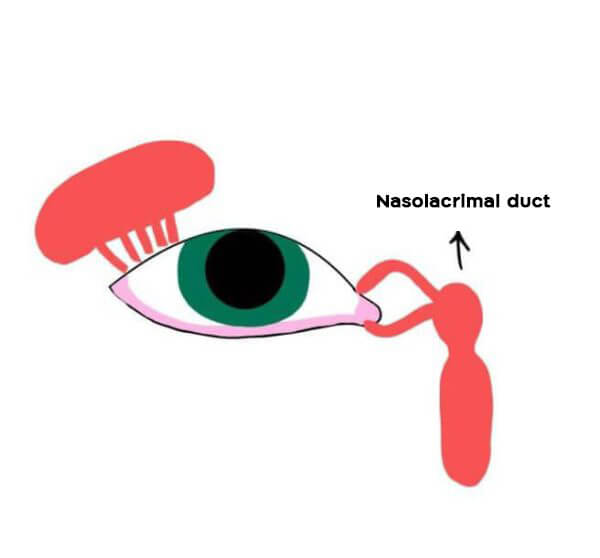
Nasolacrimal duct obstruction (blocked tear-ducts) in infants
Nasolacrimal duct obstruction (also known as blocked tear-ducts) is a very common condition in infants that concerns lots of parents.
We think that if a parent can understand the simple anatomy of the eye and this very non-complex medical condition, they will be able to better manage their child’s situation and provide them with better care.
The following post was written by a pediatric ophthalmology specialist – Dr Miriam Ehrenberg. She is a fantastic ophthalmologist and is part of the team of specialists listed on this website. You can find out more information about her in the following link here.
What is the nasolacrimal duct and where is it located?
Take a look at the image attached to this article (an image of a right eye) or take a look in the mirror.
In the corners of our eyes, closer to our nose, we all have two small holes – one in our upper eyelid and one in our lower eyelid. Naturally, tears are constantly being secreted in our eyes (not only when we cry) and drain through these small holes into a duct that leads to the nose, where they are absorbed into the mucosa of the nose.
If this duct or the holes are slightly obstructed, the drainage will not be optimal, and the eye will remain wet.
Why does the nasolacrimal duct get obstructed?
The nasolacrimal duct is quite narrow to begin with in babies. Therefore, any slight obstruction can make it even narrower and impede drainage of tears.
In about 20% of babies there is a thin membrane that obstructs the drainage of tears into the nose. This membrane is supposed to disappear before birth but sometimes this only happens after birth, and that is what causes tears and discharge in one or both eyes.
Sometimes this obstruction presents immediately after birth and at other times it only happens later, when the baby starts producing tears.
Note that in some cases of obstruction, there are no signs or symptoms unless the baby gets a cold and is congested, which is when the parents might start noticing excessive tearing.
What are the signs and symptoms of obstructed nasolacrimal duct (blocked tear-ducts)?
We all produce tears constantly throughout the day. Tears cover our eyes and protect them. So, when the drainage of these tears is not right, we end up with excessive tearing of the eye. The eye will be constantly wet, especially the lower portion of it, and often there will also be yellow or clear discharge together with the tears.
The tears tend to irritate the baby, causing him/her to rub their eyes. This can lead to redness in the eye, and if prolonged, may trigger the bacteria found on the skin surrounding the eye to cause an infection. Such an infection leads to the production of yellowish/greenish discharge.
For some babies, the obstruction is unilateral, while for others it may be bilateral. Sometimes the obstruction is equal on both sides and other times it is asymmetric, causing one eye to produce more tears and discharge than the other.
How is a nasolacrimal duct obstruction treated?
Firstly, not all cases require treatment. If the eye is only slightly wet, particularly when exposed to cold environment, wind, or sun, treatment is not always necessary.
If treatment is necessary, the most important part of management is cleaning the discharge, especially in the morning when the baby awakens. The discharge and tears can irritate the eye and the skin surrounding it, causing redness and discomfort. The discharge can be cleaned with the help of cotton pads and warm water or using eye wipes. In addition, if the obstruction is severe, you can massage the area of the lacrimal duct. See below for an explanation.
Eye drops and ointments are only needed if an infection develops secondary to the obstruction.
The good news is that most cases improve with time and resolve spontaneously by the age of 1.
How can one massage the nasolacrimal duct?
Start by washing your hands.
Place your finger on the inner area between the eye and the nose, just above the nasolacrimal gland and produce a gentle pressure downwards. Sometimes when this maneuver is carried out on a baby with a nasolacrimal duct obstruction, discharge are released either from the eye or nose. This means it worked.
This massage should be repeated by pressing on the site several times, twice or three times a day.
What happens to an obstructed nasolacrimal duct over the course of months?
As the baby grows, the duct grows and/or the membrane that was blocking the duct opens and the problem resolves in most cases.
If the problem does not resolve spontaneously within 10-11 months, a pediatric ophthalmology specialist should be consulted, and surgical intervention should be considered.
In any case, keep in mind that we recommend visiting a pediatric ophthalmologist when your child is around 1 year old, just as a screening visit, even where there aren’t any ophthalmologic concerns.
Good luck!
For comments and questions, please register
